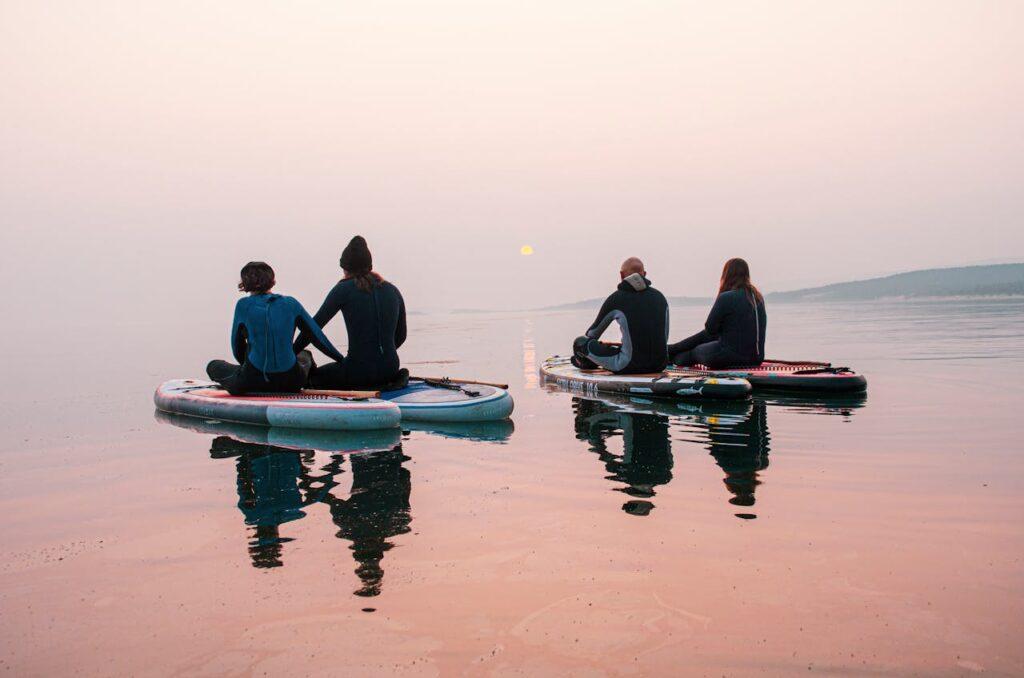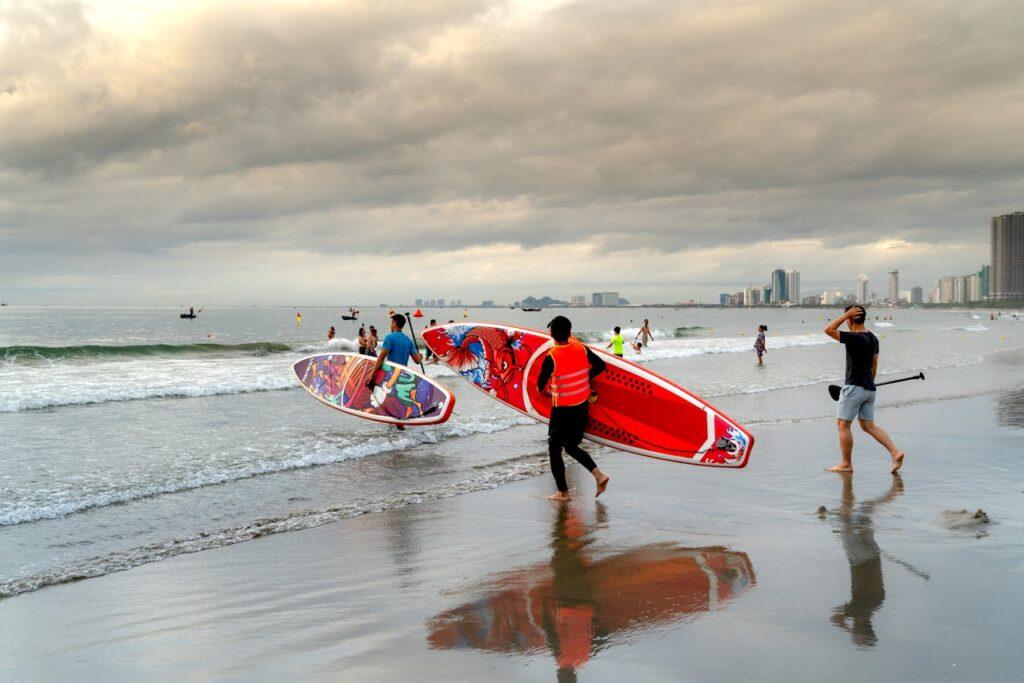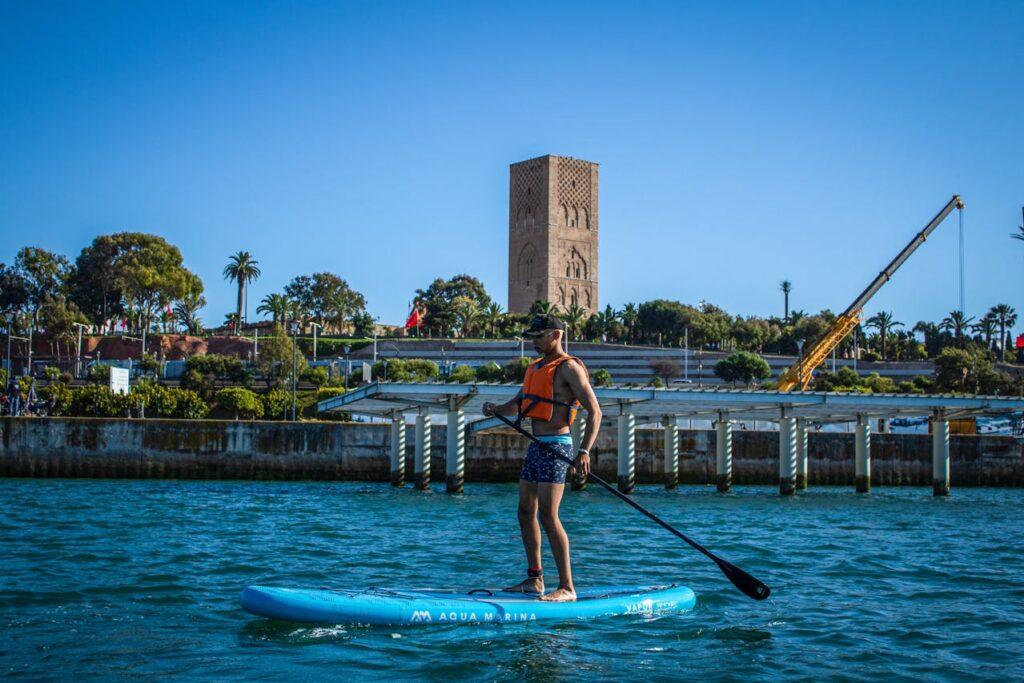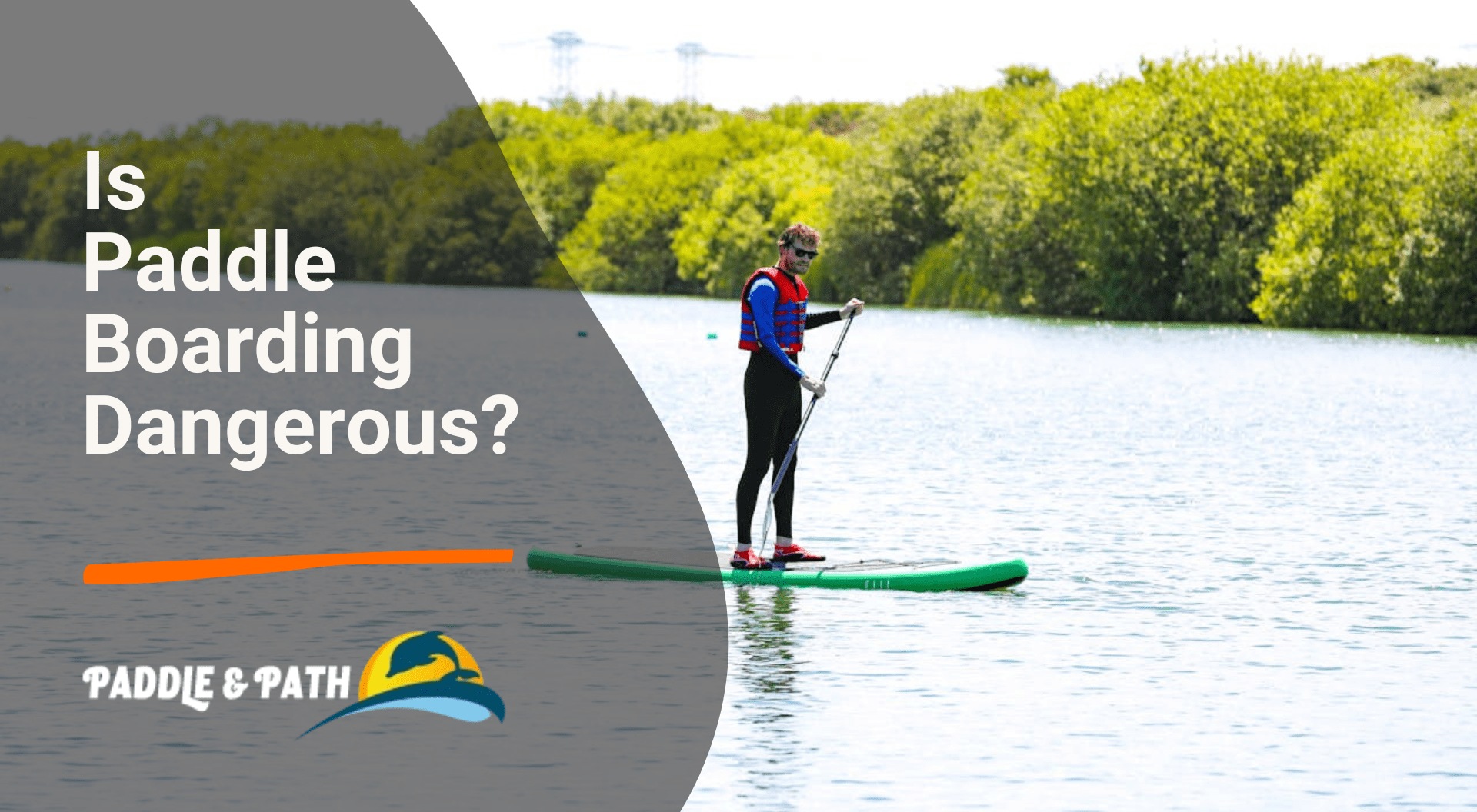I get a lot of questions from beginners or people wanting to start, asking me is paddle boarding dangerous?
Paddle boarding has become a popular water sport for many enthusiasts, offering a variety of styles to suit different preferences and skill levels. From surfing to touring, racing to yoga, there are options for everyone to enjoy.
Like any water activity, paddle boarding does come with potential risks such as drowning, collisions, falls, and hypothermia. To ensure a safe experience, it is essential to follow safety guidelines such as wearing a life jacket, checking weather conditions, and staying within your skill level.
Despite the risks, the benefits of paddle boarding are numerous, including a full-body workout, low-impact exercise, stress relief, and a chance to connect with nature.
Explore the world of paddle boarding and discover why it has captivated so many water enthusiasts.
Is Paddle Boarding Dangerous?
The quick answer is, there are always risks when paddle boarding in any body of water, but if you prepare correctly and plan your adventure, you mitigate the risk of any potential dangers.
In this article, we will cover everything you need to know in order to make your supping adventure safe and enjoyable.
In this article:
What Is Paddle Boarding?
Paddle Boarding is a popular water sport and outdoor activity that offers a unique blend of adventure, fun, and exercise amidst the beauty of nature, making it an ideal leisure pursuit for individuals and families alike.
The appeal of paddle boarding lies in its ability to provide a full-body workout while allowing participants to soak in the tranquility of water surroundings. This activity not only lets you explore serene water bodies but also serves as a fantastic way to bond with family members.
Whether you’re gliding through calm lakes or riding the waves at the beach, paddle boarding offers a versatile experience suitable for all skill levels. It’s a wonderful way to unplug from the chaos of daily life and connect with nature in a refreshing and enjoyable manner.

What Are The Different Types Of Paddle Boarding?
Paddle Boarding offers various types that cater to different preferences and skill levels, including Surfing, Touring, Racing, and Yoga, each providing a distinct and exciting water sport experience filled with adventure and fun.
- Surfing is all about riding the waves and mastering the art of balance and agility on the board. It requires a good sense of timing and wave selection, making it an exhilarating challenge for those seeking an adrenaline rush.
- Touring, on the other hand, allows paddlers to explore scenic waterways and coastlines, providing a peaceful and meditative experience.
- Racing involves speed and endurance, perfect for those who enjoy a competitive edge.
- Yoga paddle boarding combines the tranquility of yoga with the serenity of being on water, offering a unique mind-body workout amidst serene surroundings.
Surfing
Surfing and paddle boarding involve riding waves and mastering the art of balance and agility on the board, requiring a certain skill level to navigate the waves and experience the thrill of this adventurous water sport.
As you glide along the water, feeling the energy of the waves beneath you, the key is to find that perfect balance between control and surrender to the natural forces.
It’s about understanding the ebb and flow of the ocean, anticipating the rise and fall of each wave to catch that exhilarating ride.
Paddle board surfing challenges not only your physical abilities but also your mental focus, teaching you to adapt swiftly to changing wave dynamics and make split-second decisions to stay upright and harness the power of the sea.
Touring
Touring paddle boarding offers a serene and leisurely water sport experience, allowing enthusiasts to explore scenic waterways, enhance their stability and strength, and enjoy quality family time amidst breathtaking natural surroundings.
The gentle rhythm of paddling along tranquil waters not only provides a unique way to connect with nature but also serves as an excellent form of relaxation and rejuvenation.
As families navigate the calm currents together, they bond over shared moments of exploration and discovery, fostering a sense of unity and togetherness.
With each stroke, participants not only build physical strength but also mental resilience, as they immerse themselves in the peaceful enjoyment of the surrounding landscapes, creating lasting memories that will be cherished for years to come.
Racing
Paddle board racing is a thrilling water sport that combines speed, competition, and the adrenaline rush of high-paced action, challenging participants to showcase their skill levels in an exciting and competitive environment.
Whether racing against the clock or competing head-to-head, paddle board racers must navigate choppy waters, master the art of balance, and paddle with precision to gain an edge over their opponents.
The competitive spirit in paddle board racing pushes athletes to their limits, driving them to push harder, paddle faster, and outmaneuver rivals with strategic moves.
The exhilarating feeling of gliding across the water, the wind in your face, as you surge ahead of the competition, is unmatched in the world of watersports, making paddle board racing a heart-pumping experience that keeps participants coming back for more.
Yoga
Paddle board yoga combines the tranquility of yoga practice with the dynamic challenge of balancing on water, offering a unique water sport activity that promotes relaxation, health benefits, and mindfulness in a serene natural setting.
Engaging in yoga on a paddle board requires a heightened sense of focus and stability, as practitioners move through various poses while floating on the gentle ripples of the water.
The fusion of yoga and paddle boarding encourages individuals to tune into their surroundings, finding a deep connection with nature and themselves. This harmonious blend of physical exercise and mental relaxation not only enhances strength and flexibility but also cultivates a profound sense of inner peace and serenity.
The gentle swaying of the board adds an extra element of challenge, requiring practitioners to be fully present in the moment, fostering a deeper state of mindfulness throughout the practice.
What Are The Potential Risks Of Paddle Boarding?

While paddle boarding can be an exhilarating activity, it also carries potential risks such as accidents, injuries, drowning, and the need for rescue due to factors like water conditions, hazards, and lack of necessary safety precautions.
These risks can escalate quickly if paddlers underestimate the power of currents or fail to wear a properly fitted life jacket. Inexperienced individuals may find themselves in challenging situations, such as strong winds pushing them off course or sudden changes in weather conditions.
Without proper training and awareness, even a calm-looking water surface can hide dangerous undercurrents or submerged obstacles. Therefore, acknowledging these dangers and taking appropriate safety measures is crucial for a safe and enjoyable paddle boarding experience.
Drowning
Drowning is a serious risk in paddle boarding, highlighting the critical importance of safety measures, supervision, and the use of life jackets to prevent tragic accidents and ensure water sport enthusiasts remain safe on the water.
As with any water activity, understanding the potential risks and taking appropriate precautions is key to a fun and safe experience.
Adequate supervision, especially for beginners or in challenging conditions, can greatly reduce the chances of accidents. Life jackets, which are designed to keep a person afloat in the water, should be worn at all times while paddle boarding.
By prioritizing water safety and risk prevention, enthusiasts can enjoy their time on the water while minimizing the dangers associated with this exhilarating sport.
Collisions
Collisions pose a notable risk in paddle boarding, emphasizing the need for safety awareness, proper navigation skills, and vigilance amidst varying water motions to prevent accidents and injuries while enjoying this water-based activity.
Being mindful of your surroundings is crucial when paddle boarding, especially in busy waterways where the risk of collisions is heightened.
By understanding safe navigation techniques, such as yielding to larger vessels and respecting right of way rules, you can significantly reduce the chances of accidents.
It’s also essential to pay attention to water motion dynamics, such as currents and waves, as they can impact your stability and course while out on the water. By staying alert and responsive to these factors, you can enhance your safety and enjoyment of paddle boarding.
Falls and Injuries
Falls and injuries are common risks in paddle boarding, underscoring the importance of maintaining balance, building strength, and being prepared for emergencies to minimize the likelihood of accidents and injuries during this water sport activity.
Having a strong sense of balance is essential for navigating the sometimes choppy waters while paddle boarding.
By honing physical strength through regular exercise and strength training, individuals can better withstand unexpected challenges that may arise on the water.
Being equipped with proper emergency response techniques, such as knowing how to perform rescues or administer first aid, can make a significant difference in ensuring the safety of oneself and others during paddle boarding excursions.
Hypothermia
Hypothermia is a potential risk in paddle boarding, emphasizing the need to consider water conditions, weather factors, and appropriate protective gear to prevent the onset of this dangerous condition and ensure paddlers stay warm and safe on the water.
The impact of water conditions like cold temperatures and strong currents can accelerate heat loss from the body, making paddlers more susceptible to hypothermia.
Weather elements such as wind chill can further lower body temperature, highlighting the crucial role of insulating layers and waterproof clothing in retaining warmth.
Proper thermal regulation through wearing wetsuits or drysuits, along with accessories like neoprene gloves and booties, becomes essential to ward off the chilling effects of cold water and maintain a comfortable body temperature for a safe and enjoyable paddle boarding experience.
How Can Someone Stay Safe While Paddle Boarding?

Ensuring safety while paddle boarding involves taking necessary precautions such as assessing water conditions, matching skill levels to experience, using proper equipment, seeking supervision, and staying informed about changing weather patterns for a secure and enjoyable experience on the water.
It is crucial for paddle boarding enthusiasts to be mindful of potential hazards that may arise in different water bodies. Before embarking on a paddling adventure, it is essential to conduct a thorough evaluation of the water conditions, including currents, tides, and any potential obstacles.
Aligning one’s experience level with their skill proficiency is key to preventing accidents and ensuring a smooth ride. Utilizing appropriate safety equipment, such as a personal flotation device and a leash, can significantly reduce the risk of incidents.
Seeking guidance or supervision from experienced paddlers or instructors can also enhance safety awareness and provide valuable insights. Keeping a close eye on weather forecasts and being prepared to adjust plans based on changing conditions is vital for a safe and enjoyable paddle boarding experience.
Wear A Life Jacket
Wearing a life jacket is a crucial safety measure in paddle boarding, providing essential buoyancy, protection, and peace of mind by ensuring the proper fit and selecting quality materials for enhanced safety on the water.
A well-fitted life jacket not only keeps you afloat but also helps in maintaining proper body position in the water, preventing fatigue and strain while paddling.
The buoyancy offered by a life vest ensures that you stay on the surface, making it easier for others to spot you in case of an emergency.
Modern life jackets are designed with comfort in mind, allowing you to move freely without feeling restricted during your paddle boarding adventures.
Check Weather Conditions
Checking weather conditions before paddle boarding is critical for safety, involving a thorough assessment of wind speeds, forecasts, and potential changes to ensure a safe and enjoyable water activity experience without unexpected weather-related risks.
Considering wind awareness is fundamental as gusty winds can pose challenges on the water, making it crucial to choose appropriate routes and adjust paddling techniques accordingly.
In addition, staying updated with weather forecasts allows paddlers to anticipate any upcoming changes in conditions, helping to prevent being caught off guard by sudden storms or shifts in wind direction.
By staying vigilant and prepared for weather alterations, individuals can significantly reduce the risks associated with paddle boarding in changing weather patterns.
Stay Within Your Skill Level
Staying within your skill level while paddle boarding is essential for safety, as matching experience to the difficulty of the activity minimizes the risks of accidents, injuries, and potential hazards associated with exceeding one’s expertise on the water.
By knowing your capabilities and limitations, you can ensure a more enjoyable and secure paddle boarding experience. Progressing gradually allows for skill assessment and the development of expertise, reducing the chances of encountering unforeseen dangers.
It’s crucial to prioritize risk management by understanding the environment, weather conditions, and equipment usage. Choosing routes and challenges that align with your current abilities fosters growth while maintaining a safe and controlled environment.
Remember, honing your skills over time leads to a deeper appreciation of the sport and enables you to navigate various water conditions confidently.
Use A Leash
Using a leash is a safety essential in paddle boarding, ensuring board attachment to the paddler for stability, preventing board drift, and facilitating quick rescues in case of falls or unexpected water conditions during the activity.
The leash serves as a crucial link between the paddler and the board, especially in rough waters or crowded places where losing control of the board can be risky.
By keeping the board nearby, the leash not only enhances the rider’s balance but also aids in maneuvering swiftly if needed. In situations like sudden wind gusts or large waves, the leash acts as a lifeline, allowing for immediate recovery and reducing the risk of losing the board altogether.
Avoid Distractions
Avoiding distractions is crucial for safety in paddle boarding, emphasizing the need for focus, concentration, and situational awareness to minimize risks and ensure an uninterrupted and secure water activity experience.
Maintaining focus while paddle boarding not only enhances safety but also allows for a more enjoyable and immersive experience on the water. By staying alert and attentive to your surroundings, you can better respond to changing conditions and potential hazards.
Consistent concentration enables paddlers to navigate currents, waves, and obstacles with precision, reducing the likelihood of accidents or getting off course.
Prioritizing risk reduction through focus helps in making quick decisions and executing maneuvers effectively, promoting a sense of control and confidence during your paddle boarding adventures.
What Are The Benefits Of Paddle Boarding?
Paddle Boarding offers a multitude of benefits encompassing full-body exercise, enjoyable adventures, improved health, relaxation, and a deeper connection with nature, making it a holistic and rewarding water activity choice for individuals seeking wellness and leisure.
Engaging in paddle boarding not only helps in toning muscles and enhancing balance but also provides a low-impact cardiovascular workout that boosts endurance and strength.
The sense of freedom and thrill that comes from gliding on the water surface adds an element of excitement to the exercise routine.
Being out in the open water surrounded by the serene beauty of nature promotes mental wellness, reduces stress levels, and fosters a profound sense of tranquility and rejuvenation.
Full Body Workout
Paddle boarding provides a comprehensive full-body workout that engages various muscle groups, enhances fitness levels, improves strength, and promotes balance through the dynamic movements and stability challenges of this invigorating water sport.
By paddling and propelling oneself through the water, paddle boarding requires the use of core muscles to maintain stability and balance on the board.
The continuous paddling action strengthens the upper body muscles, including the arms, shoulders, and back. The leg muscles work hard to help steer and control the board, contributing to overall lower body strength development.
This combination of muscle engagement results in a complete workout that not only boosts cardiovascular fitness but also helps in toning and sculpting the body for improved physical endurance and agility.
Low Impact Exercise
Paddle boarding offers a low-impact exercise option that promotes health and fitness by providing a gentle workout for the joints and muscles, reducing stress levels, and offering a soothing physical activity that benefits overall well-being.
The gentle nature of paddle boarding makes it an ideal choice for those seeking to improve joint health without subjecting themselves to high-impact activities.
By engaging multiple muscle groups in a balanced manner, paddle boarding helps strengthen core muscles, improve balance, and enhance overall muscle tone.
The tranquil setting of being out on the water can significantly reduce stress levels, providing a therapeutic escape from the demands of daily life and contributing to improved mental well-being.
Regular paddle boarding sessions can lead to enhanced fitness levels and a healthier lifestyle.
Stress Relief
Paddle boarding acts as a potent stress relief technique, fostering relaxation, improving mental well-being, promoting mindfulness, and facilitating a deep connection with nature through the calming and meditative aspects of this water activity.
Engaging in paddle boarding allows individuals to retreat from the hustle and bustle of daily life, immersing themselves in the soothing rhythm of the water and the gentle movements required to navigate the paddleboard.
This focus on balance and coordination can serve as a form of moving meditation, quieting the mind and allowing for a sense of inner peace to emerge.
The tranquil setting of a serene lake or ocean further enhances the experience, enveloping participants in the beauty of the natural world and fostering a sense of tranquility and rejuvenation.
Connecting With Nature
Paddle boarding facilitates a profound connection with nature, allowing enthusiasts to embrace adventurous encounters, witness wildlife up close, appreciate the environment’s beauty, and enjoy the leisurely exploration of waterways in a harmonious watercraft setting.
As individuals paddle along serene waters, the gentle sway of the paddle board merges with the natural rhythm of the surroundings, fostering a sense of oneness with the environment.
The tranquility of the landscape provides a perfect backdrop for observing the diverse wildlife that inhabits the shores and waterways, offering a rare opportunity to witness these creatures in their natural habitats.
This immersive experience not only enhances one’s appreciation for the delicate balance of nature but also creates lasting memories of peaceful moments spent amidst the wonders of the outdoors.
Get out and paddle and be safe!

